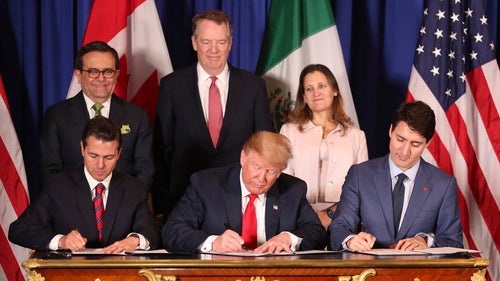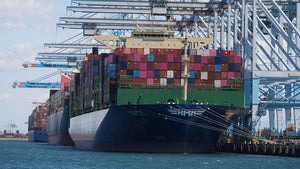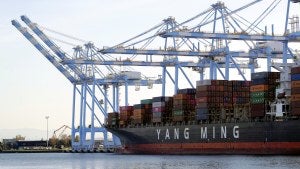Ties Unwound: The Rise and Fall of Canada-US Trade Liberalization

Decades of integration between the two North American neighbors risks coming undone.
At the Oval Office on May 6, Canadian Prime Minister Mark Carney emphasized to US President Donald Trump that Canada would never be for sale. The assertive message is a rebuke to Trump’s oft-repeated threat to entice Canada into becoming the 51st state: “This would make all Tariffs, and everything else, totally disappear.” By tying trade to takeover, Trump has struck a particularly sensitive Canadian nerve. Over a century ago, American policymakers also wielded tariffs to pressure the then-British federal dominion into their embrace.
Given repeated US attempts to annex Canada in the 19th century, often via weaponized economic dominance, the successful 1980s liberalization of Canada-US trade was no small feat. This report outlines the evolution of US-Canada trade ties and the Canadian public’s reactions to its turns. By trampling over these sensitivities, the current administration risks undoing decades of hard-earned trust—with disastrous implications for business on both sides of the border.
A Leap of Faith Into Free Trade
Given the bad blood, North American trade integration was one of the most divisive policy initiatives in modern Canadian history. Many feared that the 1987 Canada-US Free Trade Agreement (CUSFTA), negotiated between then-Prime Minister Brian Mulroney and former US President Ronald Reagan, would undermine Canadian sovereignty and threaten domestic industries. The opposition Liberal Party lambasted Mulroney as the aspiring governor of America’s 51st state and ran attack ads showing the Americans erasing the US-Canadian border.
In 2022, 35 years after CUSFTA was signed, Abacus Data found a majority of Canadians (52%) supported the agreement and just 7 percent explicitly opposed. Public opinion in the 1980s, however, reflected a concerned and divided electorate: The 1988 Canadian National Election Study shows a slim plurality of Canadians (42%) opposed the agreement in the run-up to the 1988 federal election, compared to 38 percent in support. By the end of a campaign season marked by fierce debate, however, opposition had dropped to 36 percent, and half of Canadians (49%) were willing to give “reciprocity” a try.
Though the results gave Mulroney a mandate, the public remained skeptical, and reciprocity was not yet out of the woods. A punishing recession which struck in 1990 further dampened economic optimism. Polling from the Environics Institute shows that support for North American free trade declined precipitously into the 1990s. In 1992, two years before the North American Free Trade Agreement (NAFTA) came into force, just three in 10 Canadians (29%) agreed that there should be free trade between Canada, the United States, and Mexico.
Yet liberalization steamed ahead. Canadian businesses restructured and reoriented their activities, investing in new technology to increase their competitiveness. As economic ties deepened and Canada’s export economy grew, especially in sectors like energy and automotive manufacturing, Canadians became more confident in their ability to go toe-to-toe with American firms. Support for free trade rose continuously after 1992, passing 50 percent in 1996 and reaching 72 percent in 2002. This shift is now recognized as one of the most dramatic reversals in Canadian polling history.
On Guard for Thee amidst Economic Asymmetry
Even after ratification, Canadians remained wary about the potential adverse effects of North America’s integration on their national autonomy. A 2003 survey undertaken by EKOS research associates for the Canadian Department of Foreign Affairs, Trade, and Development showed just three in 10 Canadians (28%) believed that Canada’s influence on the United States had increased in the decade since NAFTA came into force. Two-thirds (64%), in contrast, thought US influence on their own country had increased.
Nor did Canadians believe that the rules-based international order would protect them from unfair practices. In the same 2003 poll, three in five Canadians (58%) disagreed that “Because trade agreements are based on an established set of rules for all to follow, Canada is on an even footing with the United States when it comes to trade and resolving disputes.” Unsurprisingly, two-thirds (67%) believed the United States to be so large and powerful that it would inevitably emerge with the upper hand over Canada during trade disputes.
Nine years later, Canadians were not much more positive. In May 2012, Angus Reid polling showed just 8 percent of Canadians thought their country benefitted the most from the trilateral partnership, compared to 46 percent considering the United States the main winner. The same poll showed 46 percent agreeing that Canada should “do whatever is necessary to renegotiate the terms of NAFTA.”
In other words, Canadians have always been keenly aware about the cards they hold in their relationship with the United States. An overwhelming majority (86%) in the 2003 EKOS poll believed it unwise to rely so much on one trading partner and wanted to diversify to other markets for Canadian goods and services. In 2014, survey research conducted by the Angus Reid Institute showed that a third of Canadians sought to develop closer trade ties with China (34%) and the European Union (37%), roughly equal to those supporting a continued focus on trade with the United States (36%). Fully two-thirds (68%) supported a Comprehensive Economic and Trade Agreement (CETA) with the EU, with just 11 percent opposed.
The Rocky Road to Renegotiation: NAFTA, USMCA, and Beyond
After these indications of Canadian misgivings about NAFTA, Canadians ultimately rallied to its defense when Trump first threatened to tear up the agreement upon taking office in 2017. Polling conducted by the Angus Reid Institute showed that in the eight months between June 2016 and February 2017, the share of Canadians saying Canada benefitted from NAFTA jumped from 25 percent to a 44-percent plurality. The number believing that the pact had hurt their country halved (26% to 13%) after the Obama-Trump transition. Likewise, the share hoping to see NAFTA renegotiated fell from 34 percent to 24 percent during this time, mirroring a jump in the number wishing to strengthen and expand the pact (from 24% to 31%).
Despite these increases in appreciation for NAFTA, Canadians emerged disappointed with the United States-Mexico-Canada (USMCA) pact. Angus Reid polling in 2018 showed that just two-in-10 (18%) said the renegotiated trade agreement, spearheaded by Trump, was better for Canada than its predecessor. In comparison, a third (35%) saw no change and a whopping 47 percent believed it would make their country worse-off. Fully half (50%) of Canadians pointed a critical finger at their negotiators, blaming them for being too soft on the United States and giving up too much to cinch the deal.
The agreement survives for now. Certified USMCA-compliant goods, which account for 38 percent of Canadian exports to the United States, are exempt from US tariffs. However, energy products, potash, and goods that do not meet the rules-of-origin requirements were slapped with increased duties on March 7. Though claiming the USMCA tariff exemption is only a matter of paperwork for some products, economists estimate up to 20 percent of US imports from Canada cannot easily be made compliant, exposing them to the brunt of Trump’s trade policy.
In the recent Canadian federal election, Prime Minister Carney, who campaigned on his ability to stand up to Trump’s economic threats, led his party to victory on April 28. Research by the Angus Reid Institute shows just how dramatically Trump’s tariffs pushed the public toward Carney’s Liberal Party. A majority (51%) of the 63 percent of voters concerned about tariffs leaned Liberal, compared to just one-quarter (25%) of the “tariff-unconcerned,” making up 10 percent of voters.
The USMCA is due for a mandatory review by July 2026, where its signatories will decide whether to extend the agreement beyond 2036. A March survey conducted by Leger showed majorities of Americans (52%), Canadians (53%), and Mexicans (76%) in support of renewing the deal. At the same time, however, Leger polling conducted less than a week before the Canadian election shows three-quarters of Canadians (72%) in favor of dollar-for-dollar retaliatory tariffs on American goods. Tit-for-tat trade escalations would effectively render any formal trade agreement a dead letter.
Conclusion
Seen in historical context, today’s integrated North America is nothing short of miraculous. Besides being the longest border between two sovereign states, the US-Canada border is also the longest undefended border on the planet. For almost four decades, goods, services, and people have transited unimpeded across the invisible line separating the two transcontinental neighbors.
Yet Canadians have always been cautious of the institutional arrangements that have enabled integration. Generations of policymakers on both sides of the border have toiled hard to win their confidence. During Trump’s first term, his assertive 2018 renegotiation of NAFTA left Canadians disappointed and less trusting of the giant to their south. Trump’s unilateralist second-term trade policy prompted a wave of Canadian economic nationalism that propelled the Liberal Party to victory. All told, the future of the USMCA does not look bright.
Speaking on the campaign trail in March, Carney resolutely concluded that the old US-Canada relationship based on deepening ties is over. Even with the early-April pause in tariffs exempting USMCA-compliant imports, the Trump administration should rule out a turnaround in public sentiment from their northern neighbors. Moving forward, it would behoove policymakers in Washington to recall the old adage: “Trust takes years to build, seconds to break, and forever to repair.”


Related Content
 Global Economy
Global Economy
Most think Trump is focusing too much on tariffs and not enough on the rest of the economy. A few, however, think trade barriers are worth the price.
 Public Opinion
Public Opinion
Large majorities of the public view international trade as good for the US economy, job creation, and people like them.
 Global Economy
Global Economy
"When you have a week like we've had with the stock market dropping that amount, it scares people, so they stop buying things," Cécile Shea says.
